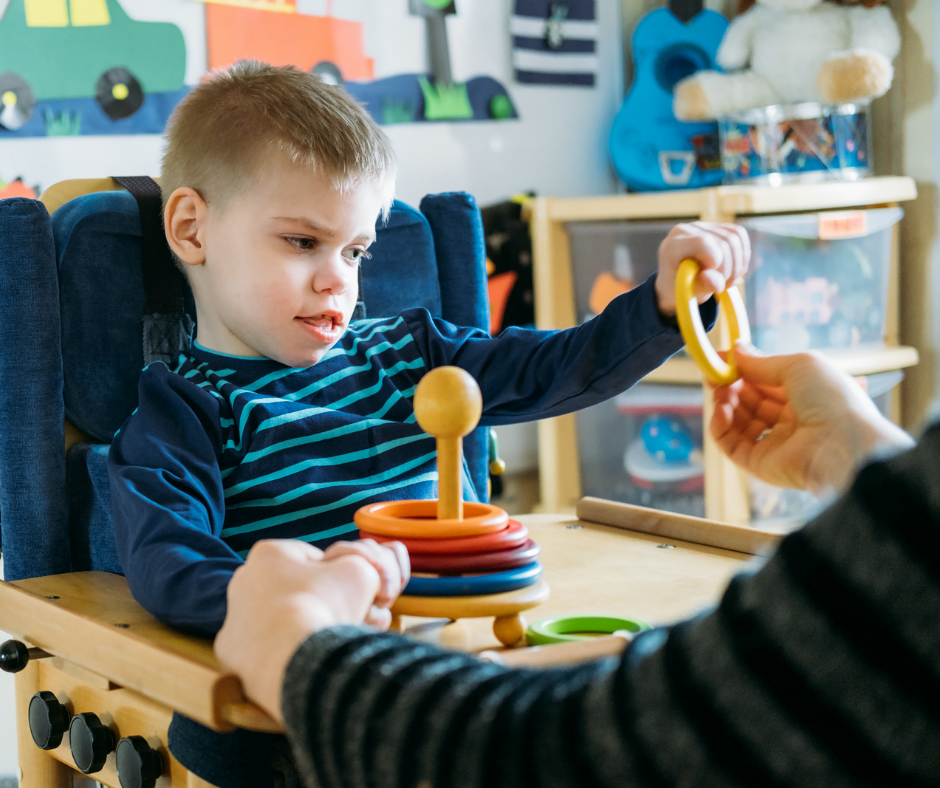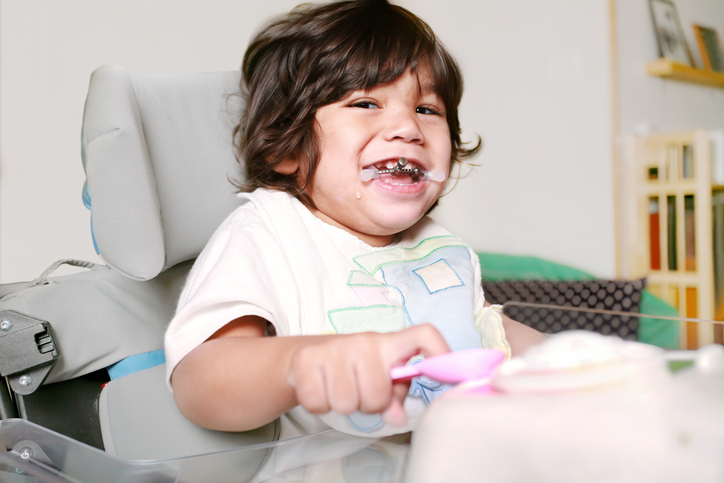-
 CEREBRAL PALSY SEIZURES & SEIZURE CONTROL Many people associate seizures as symptoms of episodes that occur...
CEREBRAL PALSY SEIZURES & SEIZURE CONTROL Many people associate seizures as symptoms of episodes that occur... -
 CEREBRAL PALSY & EPILEPSY Approximately half of the children diagnosed with cerebral palsy also have epilepsy....
CEREBRAL PALSY & EPILEPSY Approximately half of the children diagnosed with cerebral palsy also have epilepsy.... -
 CEREBRAL PALSY & MOBILITY DEVICES Using a mobility device is a common necessity in many cerebral...
CEREBRAL PALSY & MOBILITY DEVICES Using a mobility device is a common necessity in many cerebral...

CEREBRAL PALSY SEIZURES & SEIZURE CONTROL
Many people associate seizures as symptoms of episodes that occur in children diagnosed with cerebral palsy (CP). Although not every child with cerebral palsy experiences seizures, the possibility of a seizure remains a fact of life for many of these children. While medical professionals can formulate a comprehensive plan to help address the condition, parents can empower themselves with information on how to recognize the onset of a seizure and become prepared to act when a seizure occurs.
CAUSES & RISK FACTORS
WHAT IS A SEIZURE?
A seizure is a sudden disruption in the brain or nervous system that causes the body to lose consciousness, convulse, or seize. Disruptions that cause these convulsions may result from brief disruptions in an uninjured brain, lapses stemming an internal medical condition, or neurological issues related to a separate external injury. Since the nervous system is responsible for sending signals through the rest of the body, the onset of a seizure may affect the body’s essential functions and devolve into a serious medical situation.
What are the Common Triggers for a Seizure?
Although situations can differ, some of the most common triggers for a seizure include the following:
- Brain damage
- Medicine reactions
- Electrolyte imbalance
- Low blood sugar
- High fever or infections
- Genetic or congenital disorders
- Head injury
- Tumor
- Holding breath too long (in developing children)
- Lead poisoning
It is also important to note that while most people associate seizure with epilepsy, having a seizure does not automatically mean that a child has epilepsy. The term “epilepsy” refers to a long-term neurological condition characterized by a tendency for recurrent seizures. A “seizure” refers specifically to the burst of uncontrolled electrical activity between brain cells or nerve cells, a disruption that results in temporary convulsions, seizing, jerking, or twitching.
TYPES OF SEIZURES
WHAT ARE THE TWO TYPES OF SEIZURES?
There are two main types of seizures: generalized seizures and partial seizures. Many children with cerebral palsy experience at least one of these two types of seizures during their lifetimes.
Generalized Seizures
Generalized seizures happen when abnormal electrical impulses occur in all areas (both hemispheres) of the brain. This is a serious occurrence that can result in loss of bodily control or consciousness. There are five types of generalized seizures:
- Tonic-Clonic (or Grand Mal) – Tonic-clonic is the most common generalized seizure. It is also the most severe of all seizures. Symptoms include initial rigidity (the body initially goes stiff) followed with convulsions (violent shaking and spasms) and then loss of consciousness (often with the person’s lips or face turning blue). Prior to the seizure, the person may experience dizziness, hallucinations, or changes in smell or taste. Jerking limbs and biting tongue may occur as the brain tries to get the impulses under control. Upon regaining consciousness, the person may still feel nauseated or lethargic. Individuals who are diabetic, convulse for more than five minutes, experience a second seizure after the first, or feel injuries should get immediate medical attention.
- Petit Mal (or Atypical Absence) – These seizures are characterized by a sudden but short lapse in awareness (about 20 seconds or less). Over 90% of affected individuals also experience abrupt hyperventilation immediately before the seizure. At the onset of the seizure, the person may show a blank stare, brief upward roll of the eyes, or fluttering eyelids. The person is usually unresponsive during the 20-second seizure but awake (and disoriented) immediately after the seizure. Petit mal seizures usually start between ages 4 and 14. Around 70% of children outgrow absence seizures by age 18. It is important to note that petit mal seizures are generalized seizures (and therefore should not be confused with partial seizures which require different treatment methods).
- Myoclonic – Characteristics of this seizure involve involuntary jerking of the arms, legs, face, or torso. The seizure can startle the individual and others since it occurs without warning and resembles the reaction to a sudden electric shock. Myoclonic seizures usually begin during childhood, and the incidents typically occur upon waking up or falling asleep.
- Atonic (or Astatic, Akinetic, Drop Attack) – Drop attack seizures refer to temporary limpness or loss of muscle tone. A child or adult suffering from a drop attack or atonic seizure can unexpectedly collapse; therefore, some medical professionals prescribe face shields or protective head gear. These seizures may occur multiple times a day.
- Infantile Spasms (or West Syndrome) – Primarily impacting babies from age 3 months to 2 years old, infantile spasms can cause a child to experience a quick succession of jerky movements while sitting or reclining. Children with this condition may develop other types of seizures later in life.
Partial Seizures
Partial seizures affect only one hemisphere of the brain. The physical, emotional, and/or sensory effects of a partial seizure depend on its location in the brain. For example, a partial seizure in the temporal lobe can affect thoughts and perception. Alterations in primary motor cortex can cause involuntary jerking or body movements. There are two types of partial seizures:
-
- Simple Partial Seizure – This type of seizure occurs in the temporal lobe, thereby altering a child’s full awareness. Although the children with the condition may not remember the seizures after the fact, they often report extremes in emotion (happiness or sadness) following the occurrence.
- Complex Partial Seizure – This type of focal onset seizure can impair consciousness and spatial perception. Objects can be further or closer than they appear. Symptoms include compulsive chewing, repetitive limb movement, or loss of consciousness.
SYMPTOMS & TREATMENT
What are the symptoms of a seizure?
Symptoms can vary based on type of seizure. Parents should not feel discouraged since the signs of an oncoming seizure may not seem apparent at first. With the right diagnosis, parents can become more adept at recognizing the warning signs. Some common symptoms include the following:
Before the Seizure
-
-
- Unusually repetitive eye-blinking or lip-smacking
- Prolonged staring or sudden change in demeanor
- Hyperventilation
- During the Seizure
- Convulsions
- Body stiffening
- Spasmodic movements
- Shaking, twitching, tremors, or spasticity
- Unconsciousness
- Lip biting, drooling, difficulty speaking
- Unusual eye movement, whether staring or blinking
- Elevated heart rate
- Inability to sit or stand
- Loss of bladder control and/or bowel control
- Loss of consciousness
- Screaming or other verbal cues
-
After the Seizure
-
-
- Difficulty speaking
- Exhaustion
- Headaches
- Muscle limpness or weakness
- Thirst
- Upset stomach or nausea
- Bodily pain or evidence of injury
-
What are the DOs and DON’Ts of Managing a Seizure?
DO:
-
-
- Use a baby monitor to check on your child at consistent intervals (especially during sleep)
- Remove sensory stress triggers (such as loud noises)
- Keep your child away from hard surfaces or unsafe objects
- Use protective blankets and soft play areas
- Select loose instead of tight-fitting clothing
- Comfort the child after a seizure has ended
- Seek immediate medical attention in any of the following circumstances:
- The child has never had a seizure previously
- The child is not breathing, or airway seems obstructed
- The seizure lasts longer than 10 minutes
- There are multiple seizures in rapid succession
- The child’s skin changes color
- There is bodily injury
-
DON’T:
-
-
- Do not put a tongue depressor or other objects in the child’s mouth
- Do not try to restrain the child from moving during the episode
- Do not give the child objects
- Do not try to administer food or liquid during the episode
-
What Help Might Be Available for Seizures?
Although the occurrence of this condition is understandably upsetting, the condition is not without hope. The first step in determining what help might be available for seizures is to provide your medical professional with the following information:
-
-
- When does your child experience seizures and how long do they last?
- Does the seizure involve the entire body?
- If not, what parts of the body? (i.e., arms, legs, one side of body, etc.)
- What symptoms have you observed before, during, and after the seizures?
-
These clues can help medical professionals narrow down the type of seizure and prescribe treatment. Although there is no one-size-fits-all treatment for seizures, the medical professional can plan intervention that may lower the frequency and severity. For example, a doctor may prescribe anticonvulsant drugs or mood stabilizers and assign a neurologist to monitor the condition and ensure the treatments are beneficial or helpful. Your medical professional may suggest a well-balanced diet low in processed foods or carbohydrates to decrease the likelihood of high blood pressure. The child might also need to participate in therapy or intervention services for gross motor stability and stress management. In extreme cases and as a last resort, the child may need to undergo surgery to receive a nerve-stimulation device to help control seizures.
For more information, contact us.



